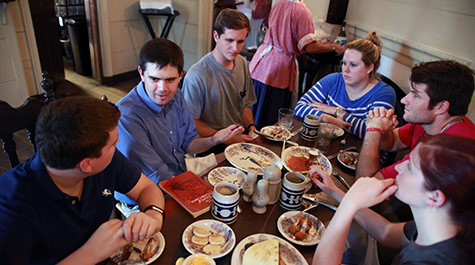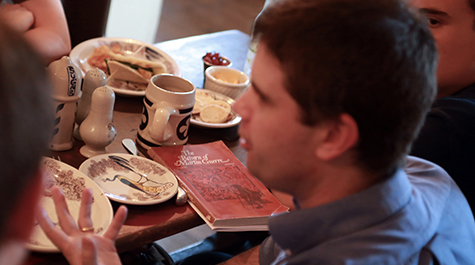Reading Groups Make for Lively Discussions Among Faculty and New Students
There are many fears that are common among incoming law students. For some, there is nothing scarier than an unsolicited interaction with one of those incredibly smart law professors at the front of each classroom.
But that was not the case at Chowning’s Tavern in Colonial Williamsburg, where six 1L students gathered with Professor Thomas J. McSweeney on a hot August day to discuss “The Return of Martin Guerre” by historian Natalie Zemon Davis. The book explores a legendary sixteenth-century French legal case.
As they sipped on cold beverages and enjoyed some appetizers, the group engaged in a lively chat about various themes presented in the book, including the French legal system in the Middle Ages, the role of women during that time period, and the growth of state power over the church. Over the course of that discussion, the students connected with the professor and got to know each other.
“One of my goals was to get people talking to each other, and I thought that went very well,” McSweeney said, reflecting on the meeting. “There were interesting questions and reactions, and the conversation was very lively and collegial.”
McSweeney’s group is one of 14 led by faculty that make up William & Mary Law School’s 1L Reading Group Program. Among the books chosen this year by participating faculty for discussion were “The Autobiography of an Execution” by David R. Dow, “Gideon’s Trumpet” by Anthony Lewis, and “Between the World and Me” by Ta-Nehisi Coates. (SEE THIS YEAR'S LIST of books and faculty discussion leaders.) According to Rhianna Shabsin, Senior Assistant Dean for Admission, there were 159 1L participants this year (more than two-thirds of the new class).
Over the summer, all incoming 1L students were sent an email inviting them to sign up for a group. Professors then reached out to the students in their groups to schedule a time and place to meet. Many groups met at restaurants or at professors’ homes.
Vice Dean Laura Heymann said the program was launched in 2015 to provide new students with an opportunity to get to know the school’s faculty and to expose students to legal topics in a casual setting.
The reading groups covered a large array of legal topics, including legal history, religion, terrorism, race, criminal justice, and feminism. They were all designed to help students think about the law and to prompt discussions about important legal and social issues.
For example, McSweeney said he chose “The Return of Martin Guerre” because it helps provide a framework for students to understand legal texts. He said that the story is constructed using facts from depositions that later permit the judge—and by extension the reader—to draw conclusions about the heroes and villains.
“It helps us understand how legal actors become characters in a story,” he said. “Events may not have significance at the time of occurrence, but they must come together in the end to tell the story.”
Kelly Ann McCarthy, a 1L student in McSweeney’s group, said that she participated in the program because she thought it would be a good opportunity to get to know a professor outside of class, as well as an excuse to read something other than a legal casebook.
“It was interesting to see how students applied what we were learning in class to non-class materials, and how different aspects of the law met in one place,” she said. “It was also interesting to see how records of legal proceedings provide a window into a different time.”
Heymann said that she had received very positive feedback about this year’s program.
“Both students and faculty seemed to have really enjoyed the experience,” she said. “I’ve heard from some students that the books they discussed caused them to see things in new ways, both within and outside the classroom.”
The 2016 book list included "The Anatomy of Violence: The Biological Roots of Crime"; "Two Boys, Divided by Fortune, United by Tragedy: A True Story of the Pursuit of Justice"; "On the Run: Fugitive Life in an American City"; "The Autobiography of an Execution"; "The Dark Side: The Inside Story of How the War on Terror Turned Into a War on American Ideals"; "Our Declaration: A Reading of the Declaration of Independence in Defense of Equality"; "Gideon’s Trumpet"; "A Civil Action"; "Between the World and Me"; "Justice: What’s the Right Thing to Do?"; "Capital in the Twenty-First Century" (Parts I and II and Selections from Part III); "All the Single Ladies: Unmarried Women and the Rise of an Independent Nation"; "The Return of Martin Guerre"; and "The Mormon Question: Polygamy and Constitutional Conflict in Nineteenth-Century America."
About William & Mary Law School
Thomas Jefferson founded William & Mary Law School in 1779 to train leaders for the new nation. Now in its third century, America's oldest law school continues its historic mission of educating citizen lawyers who are prepared both to lead and to serve.

